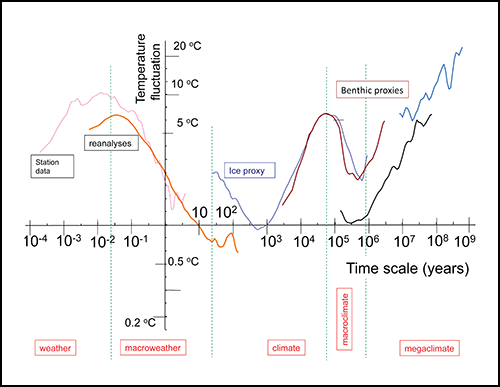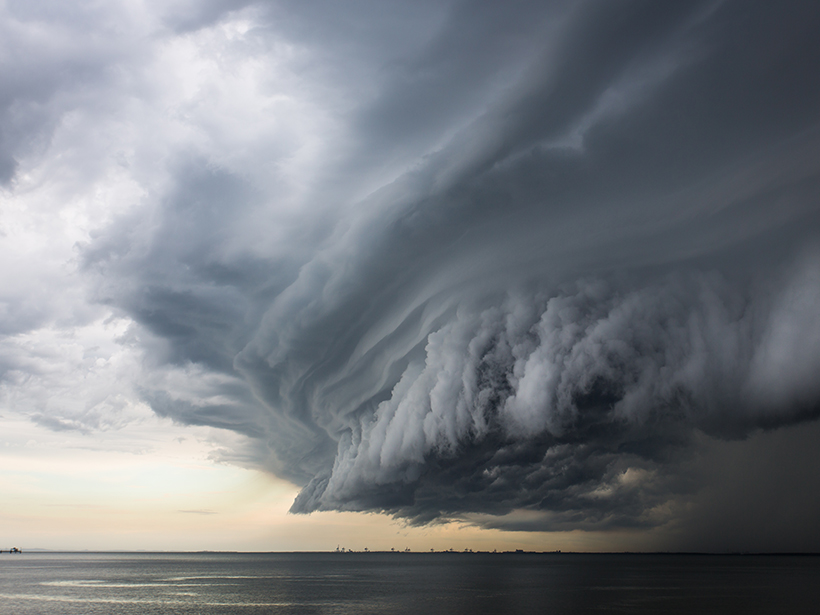The atmosphere is highly variable—more than 20 orders of magnitude in time and 10 in space: billions of years to milliseconds and tens of thousands of kilometers to millimeters.
In spite of this, almost all approaches to atmospheric variability focus on processes acting over narrow ranges of scale, such as El Niño or the diurnal, annual, and Milankovitch cycles. Empirical analyses show that most of the variability is in the continuous “background” (Figure 1), and over several wide ranges this can be well approximated by (scaling) power laws. The evaluation of the background shows that there is a need to find effective ways to characterize climate fluctuations, to understand their causes, and to focus on these aspects when analyzing both climate data and climate models.

A workshop on “Scales and Scaling in the Climate System” held in Jouvence, near Montreal, in October 2015 was organized to take a fresh look at climate variability as a distinct subject of study. To achieve this goal, it was necessary to overcome the fragmentation of the scientific community, especially between nonlinear geophysics and climate specialists. Both sectors were equally represented at the workshop, which helped the groups to foster new unity.
Participants shared expertise in climate, paleoclimate, climate modeling, nonlinear physics, statistics, and stochastics. The paleoclimate data community was well represented and provided an authoritative account of longer-term variability, as well as various shortcomings in proxy assessments. Other participants discussed the origin of long-range memory processes—patterns of correlations over long time scales—their detection and modeling and their implications for understanding spatiotemporal variability.
Some participants noted that if successive fluctuations of, for example, the temperature tend to cancel each other, then precision will be improved by averaging over a longer interval. However, if slow processes—that, for example, change the planetary albedo or carbon dioxide abundances—are acting, the system changes continuously, and averaging over longer periods to estimate the mean will be of no help. Such systems “wander”; they do not “relax.” Whether the system is wandering or relaxing is a matter of time scale: At both weather scales and multimillennium scales, the system’s temperature and other parameters wander, whereas in between, they relax (see Figure 1).
Whether a system is wandering or relaxing is a matter of time scale.
Other presentations centered on the gain between forcing and response at time scales of hundreds of thousands of years; the carbon budget; atmosphere dynamics at the Last Glacial Maximum; and the role of long-term memory processes for seasonal, annual, and decadal forecasts, for extreme events, and for global warming.
Workshop participants sought to develop a common research agenda. A number of themes emerged around the variability of climate, especially at centennial to multimillennial time scales. Participants decided to create a Past Global Changes (PAGES) working group on the theme “Climate Variability Across Scales: From Centuries to Millennia” (CVAS). In January, this theme was officially approved, so the workshop marked the beginning of a group focused on the systematic study of climate variability as a problem in its own right. The next workshop in the series will be held this November.
The workshop was co-organized by McGill University and the Université de Québec à Montréal. Funding was provided by PAGES, the Integrated Climate System Analysis and Prediction (CLISAP, University of Hamburg), McGill University, and the Centre de Recherche en Géochimie Isotopique et en Géochronologie (GEOTOP) Research network.
—S. Lovejoy, McGill University, Montreal, QC, Canada; email: [email protected]; M. Crucifix, Université Catholique de Louvain, Louvain-la-Neuve, Belgium; and A. de Vernal, Université du Québec à Montréal, Montreal, QC, Canada
Citation:
Lovejoy, S.,Crucifix, M., and de Vernal, A. (2016), Characterizing climate fluctuations over wide-scale ranges, Eos, 97, https://doi.org/10.1029/2016EO055791. Published on 14 July 2016.
Text © 2016. The authors. CC BY-NC 3.0
Except where otherwise noted, images are subject to copyright. Any reuse without express permission from the copyright owner is prohibited.

